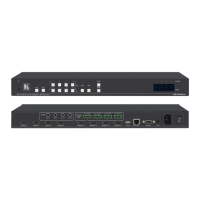Kramer Electronics Ltd.
Get MAC address.
For backward
compatibility, the id
parameter can be omitted.
In this case, the Network
ID, by default, is 0, which
is the Ethernet control
port.
COMMAND
#NET-MAC? id<CR>
FEEDBACK
~nn@NET-MAC id, mac_address<CR><LF>
id – Network ID–the device network
interface (if there are more than one).
Counting is 0 based, meaning the
control port is ‘0’, additional ports are
1,2,3….
mac_address – Unique MAC
address. Format: XX-XX-XX-XX-XX-
XX where X is hex digit
Set subnet mask.
For proper settings
consult your network
administrator.
COMMAND
#NET-MASK net_mask<CR>
FEEDBACK
~nn@NET-MASK net_mask<CR><LF>
net_mask – Format: xxx.xxx.xxx.xxx
Set the subnet mask to
255.255.0.0:
#NET-
MASK255.255.000.000<CR
>
COMMAND
#NET-MASK? <CR>
FEEDBACK
~nn@NET-MASK net_mask<CR><LF>
net_mask – Format: xxx.xxx.xxx.xxx
Get the subnet mask:
#NET-MASK?<CR>
Get device protocol
version.
COMMAND
#PROT-VER? <CR>
FEEDBACK
~nn@PROT-VER 3000:version<CR><LF>
version – XX.XX where X is a
decimal digit
Get the device protocol version:
#PROT-VER? <CR>
Get saved preset list.
In most units, video
and audio presets with the
same number are stored
and recalled together by
commands #PRST-STO
and #PRST-RCL.
COMMAND
#PRST-LST? <CR>
FEEDBACK
~nn@PRST-LST preset, preset, …<CR><LF>
Show preset list:
#PRST-LST?<CR>
Recall saved preset list.
In most units, video
and audio presets with the
same number are stored
and recalled together by
commands #PRST-STO
and #PRST-RCL.
COMMAND
#PRST-RCL preset<CR>
FEEDBACK
~nn@PRST-RCL preset<CR><LF>
Recall preset 1:
#PRST-RCL 1<CR>
Store current connections,
volumes and modes in
preset.
In most units, video
and audio presets with the
same number are stored
and recalled together by
commands #PRST-STO
and #PRST-RCL.
COMMAND
#PRST-STO preset<CR>
FEEDBACK
~nn@PRST-STO preset<CR><LF>
Store preset 1:
#PRST-STO 1<CR>
Reset device.
To avoid locking the
port due to a USB bug in
Windows, disconnect USB
connections immediately
after running this
command. If the port was
locked, disconnect and
reconnect the cable to
reopen the port.
COMMAND
#RESET<CR>
FEEDBACK
~nn@RESETok<CR><LF>
Reset the device:
#RESET<CR>
COMMAND
#SIGNAL?in_index<CR>
FEEDBACK
~nn@SIGNALin_index, status<CR><LF>
in_index – Number that indicates the
specific input: 1-4
status – Signal status according to
signal validation:
0 – Off
1 – On
Get the input signal lock status
of IN 1:
#SIGNAL?1<CR>
Get device serial number.
COMMAND
#SN?<CR>
FEEDBACK
~nn@SNserial_num<CR><LF>
serial_num – 14 decimal digits,
factory assigned
Get the device serial number:
#SN?<CR>
Get firmware version
number.
COMMAND
#VERSION?<CR>
FEEDBACK
~nn@VERSIONfirmware_version<CR><LF>
firmware_version – XX.XX.XXXX
where the digit groups are:
major.minor.build version
Get the device firmware version
number:
#VERSION?<CR>
LEGACY COMMAND.
Set video switch state.
The SET command is
for remote input switching
on Step-in clients
(essentially via by the
Web).
This is a legacy command.
New Step-in modules
support the ROUTE
command.
COMMAND
#VIDin_id>out_id<CR>
FEEDBACK
~nn@VIDin_id>out_id<CR><LF>
in_id – Indicates the ID of the input:
1-n (n= the total number of inputs)
> – Connection character between in
and out parameters
out_id –Output number
* for all outputs
Switch IN 1 to OUT 3:
#VID1>3<CR>
LEGACY COMMAND.
Set video switch state.
The GET command
identifies input switching
on Step-in clients.
This is a legacy command.
New Step-in modules
support the ROUTE
command.
COMMAND
#VID?out_id<CR>
FEEDBACK
~nn@VID>out_id<CR><LF>
in_id – Indicates the ID of the input:
1-n (n= the total number of inputs)
> – Connection character between in
and out parameters
out_id –Output number
* for all outputs
Get video switch state:
#VID?2<CR>

